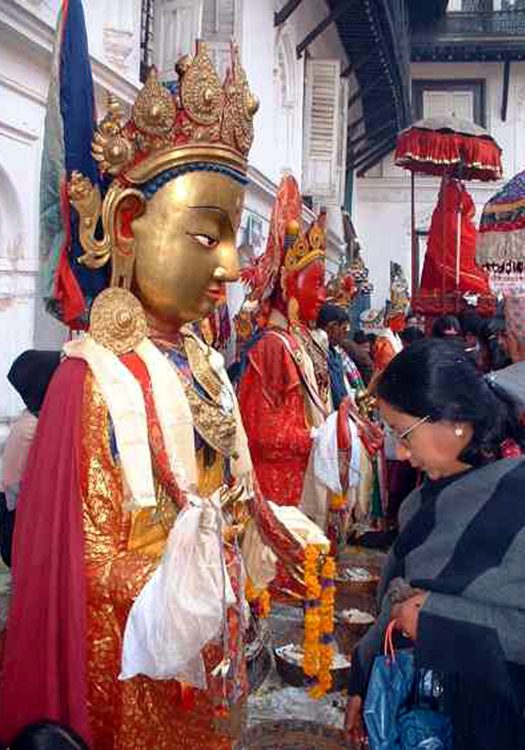Samyak on:
[Wikipedia]
[Google]
[Amazon]

 Samyak () is an almsgiving Buddhist festival celebrated in the
Samyak () is an almsgiving Buddhist festival celebrated in the

 Samyak () is an almsgiving Buddhist festival celebrated in the
Samyak () is an almsgiving Buddhist festival celebrated in the Kathmandu Valley
The Kathmandu Valley (), also known as the Nepal Valley or Nepa Valley (, Newar language, Nepal Bhasa: 𑐣𑐾𑐥𑐵𑑅 𑐐𑐵𑑅, नेपाः गाः), National Capital Area, is a bowl-shaped valley located in the Himalayas, Hima ...
in Nepal
Nepal, officially the Federal Democratic Republic of Nepal, is a landlocked country in South Asia. It is mainly situated in the Himalayas, but also includes parts of the Indo-Gangetic Plain. It borders the Tibet Autonomous Region of China Ch ...
. During the ceremony which is held on a large open ground, hundreds of Dīpankara Buddha
Dipankara (Pali: ''Dīpaṅkara''; Sanskrit: ', "Lamp bearer") or Dipankara Buddha is one of the Buddhas of the past. He is said to have lived on Earth four asankheyyas and one hundred thousand kalpas ago. According to Buddhists, Dipankara wa ...
images are assembled, and gifts of different types of food are made to the Buddha images and the Buddhist community.
Samyak is the most spectacular Newar Buddhist celebration. It is observed at different intervals in the three cities of the valley -- every 12 years in Kathmandu
Kathmandu () is the capital and largest city of Nepal, situated in the central part of the country within the Kathmandu Valley. As per the 2021 Nepal census, it has a population of 845,767 residing in 105,649 households, with approximately 4 mi ...
, every five years in Lalitpur and annually in Bhaktapur
Bhaktapur (Nepali language, Nepali and Sanskrit: भक्तपुर, ; "City of Devotees"), known locally as Khwopa (Nepal Bhasa: , ) and historically called Bhadgaon, is a city in the east corner of the Kathmandu Valley in Nepal located abou ...
. The first documented Samyak festival in Kathmandu took place in 1015 AD (135 Nepal Era).
The festival brings together a wide cross-section of Newar
Newar (; , endonym: Newa; , Pracalit script: ), or Nepami, are primarily inhabitants in Kathmandu Valley of Nepal and its surrounding areas, and the creators of its historic heritage and civilisation. Page 15. Newars are a distinct linguisti ...
society, including priests, artisans, traders, musicians and farmers. Each group has a defined role designed to highlight social harmony. The ceremony celebrates the practice of giving to the Buddhas and monks in the Newar Buddhist tradition. The Samyak festival in Kathmandu is held at Kathmandu Durbar Square and the field of Bhuikhel at the foot of Swayambhu
Svayambhu () is a Sanskrit word that means "self-born", "self-manifested", "self-existing", or "that that is created by its own accord". Various deities and entities featured in Hindu literature and tradition are regarded to be svayambhu, such as ...
hill.
Day One
On the first day, large images of Dipankar Buddha are brought out of sacred courtyards and private homes and displayed at Durbar Square in a row to receive offerings from devotees.Day Two
On the second day, the statues are carried in procession to Bhuikhel and assembled on the field. Priests receive alms consisting of different kinds of sacred foods in a ceremony held in the presence of the king. The offerings are made by members of the Uray caste group. Each subgroup performs a task that has been assigned by tradition. * Tuladhars ofAsan
Asan (; ) is a Administrative divisions of South Korea, city in South Chungcheong Province, South Korea. It borders the Seoul Capital Area to the north. Asan has a population of approximately 400,000.
Asan is known for its many hot springs an ...
sew and distribute leaf plates
* Tuladhars of Nyata cook and serve rice
* Sthapits build the wooden viewing stand
* Tamrakars play the trumpet
* Kansakars prepare and serve five types of foods
* Sikhrakars supply clay pots
* Banias serve a sweet drink
* Selaliks serve confections
Misā Samyak
Misā Samyak, which means Women's Samyak, is held on the third day. The image of Goddess Ajimā Dyah is brought down from her shrine at Swayambhu for the ceremony.Timetable
The regular Samyak ceremony is held at intervals of 12 years. However, a special one can be called between the scheduled occurrences by a sponsor. The most recent one took place in 2005. In Lalitpur, the Samyak festival is held at Nagbahal every five years. The latest one occurred in 2020. In Bhaktapur, Samyak is celebrated annually on the feast day of Ghyah Chāku Sanlhu (Maghe Sankranti
Maghe Sankranti (, , Nepal Bhasa: ) is a Nepali festival observed on the first of Magh (Nepali calendar), Magh in the Vikram Samvat, Vikram Sambat (B.S) or Yele Sambat, Yele calendar marking the end of the winter solstice and the month of Poush. ...
) which usually falls on January 15.
References
{{reflist Newar Buddhist holidays Buddhist festivals in Nepal 11th-century establishments in Nepal